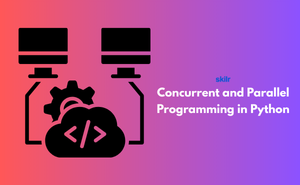👇 CELEBRATE CLOUD SECURITY DAY 👇
00
HOURS
00
MINUTES
00
SECONDS

Concurrency in Python means running multiple tasks in a way that they seem to progress together. It doesn’t mean they all happen at once, but the computer manages them so smoothly that they appear to. This is helpful when working with tasks like chat apps, where messages are sent and received at the same time, or when many things need attention without delay.
Parallelism in Python means doing many things truly at the same moment. This happens by using multiple CPU cores so that heavy tasks can be split and worked on together. For example, when processing thousands of images, each core can work on some images in parallel, making the process much faster. Together, concurrency and parallelism are powerful ways to boost performance and handle modern computing demands effectively.
This exam is ideal for:
Industry-endorsed certificates to strengthen your career profile.
Start learning immediately with digital materials, no delays.
Practice until you’re fully confident, at no additional charge.
Study anytime, anywhere, on laptop, tablet, or smartphone.
Courses and practice exams developed by qualified professionals.
Support available round the clock whenever you need help.
Easy-to-follow content with practice exams and assessments.
Join a global community of professionals advancing their skills.
Yes, cloud services often rely on concurrency and parallelism to handle distributed workloads.
Absolutely. It helps in building fast, scalable APIs and servers that handle many requests smoothly.
No, but having a multi-core processor makes parallel execution more effective.
Yes, but using multiprocessing or libraries like concurrent.futures helps overcome this limitation.
Yes, the course covers async programming in detail.
It is ideal for Python developers, data scientists, and professionals working with performance-heavy applications.
No, intermediate Python knowledge is enough, but you should understand basics of coding and problem-solving.
Finance, healthcare, AI/ML, cloud computing, web development, and gaming industries.
Concurrency handles many tasks at once by scheduling, while parallelism runs tasks at the same time on multiple processors.
Yes, parallelism is widely used in handling large datasets and training machine learning models efficiently.